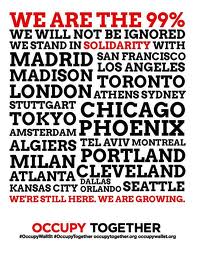Occupy TV?
 The first time I heard or saw anything about Occupy Wall Street was on Twitter. This is not shocking, but it certainly is telling. While one of TV’s selling points is its capacity to transmit events as they unfold, this tremendous technological privilege is not bestowed on all events equally. Cable news fixated on the fate of Amanda Knox in an Italian court last week, but it averts its eyes from unjust executions of Mexican nationals in the Texas penal system. This is not a new story, but it’s one that rears its head practically every day and never gets easier to process.
The first time I heard or saw anything about Occupy Wall Street was on Twitter. This is not shocking, but it certainly is telling. While one of TV’s selling points is its capacity to transmit events as they unfold, this tremendous technological privilege is not bestowed on all events equally. Cable news fixated on the fate of Amanda Knox in an Italian court last week, but it averts its eyes from unjust executions of Mexican nationals in the Texas penal system. This is not a new story, but it’s one that rears its head practically every day and never gets easier to process.
The “Occupy” movement that has taken hold in cities and towns across the United States was first ignored, then mistreated by some, revered by others, and, strangely, mocked by still others. There has been some thoughtful reporting of the movement in corporate media, and I do not want to lump all coverage together. But when I think about how anti-war protesters were marginalized by cable news in 2003 and how the Tea Party protests were glamorized in 2009, I’m quite intrigued by the TV journey this movement has taken. Three moments in the recent coverage stand out to me:
Fox News vs. Jesse LaGreca: In this interview (which actually did not air), a Fox News reporter listens to LaGreca’s eloquent defense of Occupy Wall Street, which includes a spirited critique of the news coverage. The Fox News reporter then challenges La Greca and says, “…you wouldn’t be able to get your message out there without us.” Sadly, LaGreca did not correct his interviewer. How did Occupy Wall Street launch and organize, if not via social media? TV news was late to the party but still wants to take credit for throwing it.
MSNBC takes to the streets: We all know that MSNBC has executed a few brand shifts over the years and has emerged from a confused adolescence into a focused adulthood. The brand it has settled on is “to-the-left-of-CNN,” and some of its personalities reflect this more than others. During the eight hours I’m in my office each weekday, I keep the TV on MSNBC, partly because I have no remote control for that TV. So, when I see Dylan Ratigan participating in a secular call-and-response with NYC protesters, I scrunch my face a bit and wonder whether this cheerleading is productive. I’m no believer in journalistic objectivity, but I’m also suspicious of news folks who insert themselves into the story. With Glenn Beck it was demagoguery, but with Ratigan it feels like shameless self-promotion. Which, in light of MSNBC’s recent promotional spots, fits in quite well with the network.
The Daily Show throws rotten fruit at the stage: First, I wish people would stop looking to Jon Stewart to be the voice of the young(ish) Left. He isn’t truly happy with a rally unless he’s staging it on the National Mall and taking a firm stand against taking a firm stand. And, at times, TDS goes out of its way to sever its ties with liberal causes. Case in point: Samantha Bee framing a Occupy Wall St. segment in terms of potty breaks and bad hygiene. Yes, we get it. You can be as grouchy toward these protesters as you can be toward the Tea Partiers. But without Bee’s charm, this is a Fox News story.
Aside from these moments, we see a lot of the same old material: violence-driven stories that point out the NYPD’s excessive force or dismissive stories that paint the protesters as a nuisance. As I write, @Occupy_Boston is tweeting for reinforcements as Boston PD is threatening to remove the protesters from their campsite. Impending police action was the main thrust of the local Boston news coverage of today’s largely student-led march. These stories are all to be expected. And while at one level I question the usefulness of much of this coverage, I know full well that I searched the sky fruitlessly for a news helicopter covering the Occupy Boston march I attended on October 8. There was no news helicopter. There was no aerial shot to capture the crowd of marchers descending on Newbury Street and befuddled Brooks Brothers shoppers. There were many tweets and cell phone videos that could only fit a handful of protesters into the screen. Even though television news often misses the figurative big picture, it’s the only outlet with the means to give us the symbolic value of the literal big picture.


